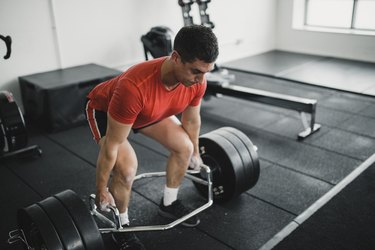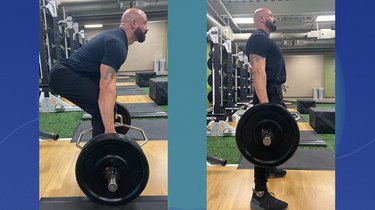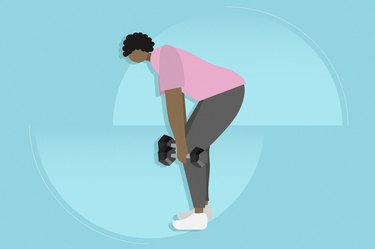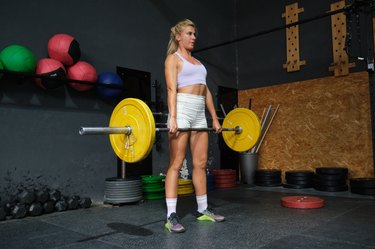

One of the beautiful things about deadlifts is that you can do them with so many different types of equipment. The trap bar deadlift is one of those variations that's particularly good for people who are just learning to deadlift and a legit option for experienced lifters — especially tall ones.
There are a lot of reasons for that, but mostly, it boils down to the fact that the trap bar's shape and handle placement makes it more ergonomic to lift.
Video of the Day
Video of the Day
It's an especially excellent piece of equipment if you're just learning the deadlift hip hinge motion, but its benefits — including less strain on the back and lower demand on grip strength — are actually relevant for anyone, no matter your lifting experience. After all, no one wants back pain and sometimes, your forearms or hands just aren't as strong as your glutes and hamstrings are. In those situations, the trap bar is here for you.
Here's what every level of lifter needs to know about the trap bar deadlift.
How to Do the Trap Bar Deadlift With Proper Form
Trap Bar Deadlift

- Stand in the center of a trap bar with your feet hip-width apart, toes facing forward.
- Keeping your back as flat as you can, bend your knees slightly, push your hips back and bend forward from your hips to reach down and grip the handles on either side, palms facing in toward your legs.
- Pull your shoulders together to create tension, and keep your neck neutral.
- Take a deep breath in as you press through your feet, squeeze your glutes, and bring your hips forward as you stand up with the weight as tall as possible. Keep your gaze a few feet in front of you.
- Stand until your knees and hips are locked out.
- Lower the weight back down to the floor with control by pushing your hips back, keeping the core engaged and back straight.
Watch the Full Trap Bar Deadlift Tutorial
6 Benefits of Deadlifting With a Trap Bar
The straight-bar deadlift, commonly known as the conventional deadlift, can feel like the gold standard of picking up and putting down weights. So maybe you're wondering if you should even bother with trap bars — also called hex bars.
What is the point of a trap bar? First, a quick explainer on what a trap bar actually is — and how it can benefit your deadlifts.
The trap bar has a hexagonal shape with high and low handles on the sides, explains Karina Wait, a certified personal trainer at Life Time Edina at Southdale in Minnesota.
Instead of standing in front of the bar and gripping it with an overhand, underhand or mixed grip like you would a straight bar, you stand in the center of a hex bar and grab onto the outside handles so that your palms are facing in toward the sides of your body.
There are some major benefits to setting up with this bar — specifically, the positioning of your center of gravity smack dab in the middle of the weight you're lifting, and the easy-to-hold handles.
According to Wait, the benefits of deadlifting with a trap bar instead of a standard barbell include:
1. Less Stress on the Lumbar Spine
The trap bar setup ends up putting you in a more erect torso posture. This ultimately will put less stress on the erector spinae, which are the deep back muscles that run along each side of the spine.
2. Less Technical Proficiency Required
Deadlifting with a trap bar eliminates some of the technical things you have to really think about with a barbell deadlift. Factors like the best grip position and how to position the barbell are removed from the equation.
While you still need to focus on some key form pointers (more on that below), deadlifts with trap bars are often easier to nail because your body's positioning makes the exercise feel a bit more natural.
3. Less Grip Strength Required
With deadlifts, grip strength is often called a "limiting factor," meaning your hands will often give out long before your glutes and hammies do.
With the hex bar, gripping the handles with your palms facing each other actually puts your hands and forearms in a stronger position.
So deadlifting with a hex bar allows you to push your muscles harder, given the same grip strength. That makes the trap bar ideal for mass gains.
4. More Stable Shoulder Position
Speaking of that neutral shoulder position: When your arms are at your sides (vs. in front of your body like with a barbell deadlift), it puts less stress on your shoulders.
This is a nice perk for anyone, but especially those who have any sort of shoulder issue that's aggravated by barbell deadlifts.
5. Easier for People Who Are Tall
The raised handles on the hex bar sit higher than an Olympic barbell, so you don't have to reach as far toward the floor to start the lift or to complete the eccentric (lowering) phase of the lift.
That's a major bonus tall people, people with long legs or anyone with tight hamstrings.
6. Greater 1RMs
The trap bar puts your center of gravity in the middle of the weight, creating a more stable (read: stronger) base. Because of this, you may be able to deadlift even more weight than you would with a regular barbell.
A 2016 study in the Journal of Strength and Conditioning Research looked at muscle activation in 20 men while deadlifting with a regular barbell and a trap bar. The results showed that the trap bar deadlift was better at producing maximal force, power and velocity.
So, if you're looking for max lifts, you might have the best luck with trap bar deadlifts.
What Muscles Does the Trap Bar Deadlift Work?
All deadlifts work the glutes, hamstrings and core, plus muscles in the back, including the spinal erectors and traps, Wait says.
The trap bar deadlift works all those muscles, but in a slightly different way than some other deadlift variations because of how the weight is distributed.
The main take-home: It works your quads more than a conventional deadlift does, according to the Journal of Strength and Conditioning Research study. (The straight barbell deadlift puts more emphasis on the hamstrings and the erector spinae, which are the deep back muscles that run along each side of the spine.)
Why is does the trap bar deadlift work the quads so well? Because it's sort of a squatty deadlift. At the bottom of each rep, your knees are bent more than in straighter-leg deadlift variations. So, to get to the top, your quads have to work that much harder.
Trap Bar vs. Conventional Deadlifts
Are trap bar deadlifts better for you? It's difficult to really give a blanket statement about which bar is the ultimate best option for deadlifting, because it really depends on your current strength, experience and body shape.
It may feel easier or more comfortable to deadlift with a trap bar. The setup is more all-levels-friendly and helps remove some of the extra factors that might throw off your form.
"The trap bar deadlift is good for anyone and everyone looking to increase their overall strength," Wait tells LIVESTRONG. "It's a great alternative to regular barbell deadlifts." And no, it's not cheating.
If you're new to deadlifts, tall or have lower back issues, it might be the most effective option for you.
However, the trap bar isn't always best. It can feel a bit confining for some people, especially those with large bodies who may prefer the sumo deadlift. Meanwhile, if you really want to focus on your posterior chain, a conventional dead is likely going to bring you closer to your goals.
Related Reading
6 Trap Bar Deadlift Technique Tips
1. Brace Your Core
Like all deadlifts, the trap bar deadlift requires some serious core activation to do the movement properly. If you're not engaging your core throughout the entire lift, you run the risk of straining your back.
"Take a big breath in before lifting to engage the core," Wait says. "Envision that you're wearing a belt or are wearing tight pants after a Thanksgiving meal and push/brace against the belt or pants throughout the entire movement. Keep this breath held in until the top."
Your breathing should be similar as you lower the bar. "I would recommend letting out some air at the top of the deadlift then taking in more air before you lower. This will assist with maintaining tension and avoiding your body from relaxing during the final part of the lift," she says.
2. Push Through Your Legs
"Lift from the legs" is a good directive for pretty much any situation where you have to pick up something heavy — including the trap bar.
"Push through the floor with your legs versus pulling with your back to keep your posterior chain straight during the first part of the movement," Wait says. This prevents your back from rounding forward and makes sure the bulk of the work goes into the lower body.
3. Extend Your Knees and Hips at the Same Time
"As you're pulling, your knees and glutes should lock out at the same time to avoid your back rounding or hips shooting up too fast," Wait says.
It's common to make the mistake of extending the legs before the hips, which makes it so that you have to really use your back to finish lifting, putting a lot of unnecessary strain on your spine.
If you can't get your hips and knees in sync, try lowering your weight or practicing with bodyweight only until you get the movement right.
4. Press Your Knees Out
This form tip is so important for so many exercises — which is why we're happy to shout it from the rooftops again here. Your knees may want to naturally cave in as you lift. Don't let them.
Instead, focus on actively pressing out as you set up and then lift the weight. Keeping the knees properly aligned will also make it easier for your knees and hips to rise simultaneously and keep the pressure in your glutes and hammies, not your back.
5. Keep Your Chest Up
This cue helps you naturally check off all the other form tips a little easier. For example, if your chest is down, you're more likely to extend your hips before your knees or use too much of your lower back to complete the lift.
6. Lift an Appropriate Amount of Weight
Yes, the trap bar deadlift is less technical than the barbell deadlift, and many people can lift heavier with a trap bar — but that doesn't mean you should come out of the gates trying to lift something way heavier than you can handle, Wait says.
"Remember to start with a light, comfortable weight and slowly add from there whenever you're doing this movement," she says.
Even after you've mastered the movement, it's a good idea to start your first set with a lighter weight so that you're warmed up and ready to go before lifting something more challenging.
FYI, "lift an appropriate amount of weight" is very sound advice for any lift, so maybe keep that in your back pocket to pull out every time you hit the gym. You can thank us later.
More Deadlifts
Was this article helpful?
150 Characters Max
0/150
Thank you for sharing!
Thank you for your feedback!


